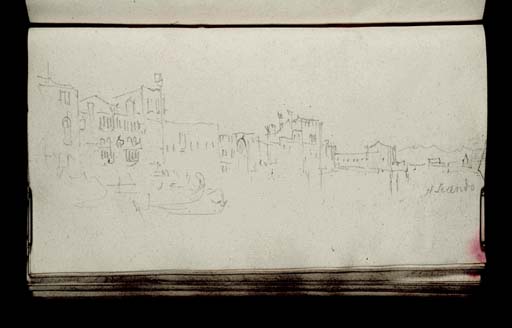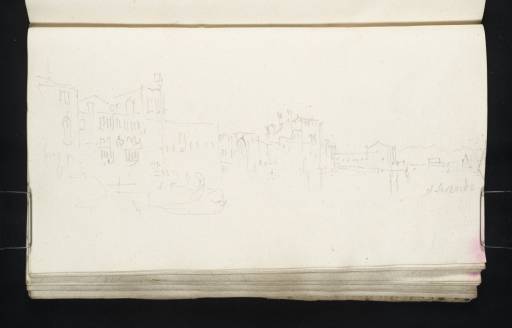Joseph Mallord William Turner The Canale di Santa Chiara at the North-West End of the Grand Canal, Venice, with the Convent of Santa Chiara and the Island of San Secondo in the Lagoon Beyond 1833
Image 1 of 2
-
 Joseph Mallord William Turner, The Canale di Santa Chiara at the North-West End of the Grand Canal, Venice, with the Convent of Santa Chiara and the Island of San Secondo in the Lagoon Beyond 1833
Joseph Mallord William Turner, The Canale di Santa Chiara at the North-West End of the Grand Canal, Venice, with the Convent of Santa Chiara and the Island of San Secondo in the Lagoon Beyond 1833 -
 Joseph Mallord William Turner, The Canale di Santa Chiara at the North-West End of the Grand Canal, Venice, with the Convent of Santa Chiara and the Island of San Secondo in the Lagoon Beyond 1833 (Enhanced image)Enhanced image
Joseph Mallord William Turner, The Canale di Santa Chiara at the North-West End of the Grand Canal, Venice, with the Convent of Santa Chiara and the Island of San Secondo in the Lagoon Beyond 1833 (Enhanced image)Enhanced image
Joseph Mallord William Turner,
The Canale di Santa Chiara at the North-West End of the Grand Canal, Venice, with the Convent of Santa Chiara and the Island of San Secondo in the Lagoon Beyond
1833
Joseph Mallord William Turner 1775–1851
Folio 78 Verso:
The Canale di Santa Chiara at the North-West End of the Grand Canal, Venice, with the Convent of Santa Chiara and the Island of San Secondo in the Lagoon Beyond 1833
D32074
Turner Bequest CCCXIV 78a
Turner Bequest CCCXIV 78a
Pencil on white laid paper, 109 x 203 mm
Partial watermark ‘C G’ (countermark)
Inscribed by Turner in pencil ‘St Secondo’ centre right
Partial watermark ‘C G’ (countermark)
Inscribed by Turner in pencil ‘St Secondo’ centre right
Accepted by the nation as part of the Turner Bequest 1856
References
1909
A.J. Finberg, A Complete Inventory of the Drawings of the Turner Bequest, London 1909, vol.II, p.1015, CCCXIV 78a, as ‘On the Grand Canal – “St. Leando (?).”’.
2003
Ian Warrell in Warrell, David Laven, Jan Morris and others, Turner and Venice, exhibition catalogue, Tate Britain, London 2003, pp.150, 264 note 2.
The Turner scholar C.F. Bell annotated Finberg’s 1909 Inventory entry (‘On the Grand Canal – “St. Leando (?).”’): ‘on the out-skirts’.1 The drawing was made with the page turned horizontally. The view is indeed on the periphery of the city, and in identifying its precise subject, Ian Warrell has compared it to a Canaletto painting of about 1772–3 in the Royal Collection, showing The Canale di Santa Chiara looking North towards the Lagoon,2 indicating the old name of this final north-western section of the Grand Canal.
The viewpoint was along the southern end of the Fondamenta Santa Chiara, near the later bridge over the twentieth-century Rio Nuovo. After considerable changes, perhaps the best vantage point today is the modern Ponte della Costituzione, crossing the last sharp turn of the canal to the Fondamenta Santa Lucia south of the railway station. The bridge now effectively frames this view from the quay, and the prospect north-north-west to the open Lagoon and the mainland is impeded by railway and road bridges across this last reach, which is narrower than in Turner’s time following reclamation on the opposite bank for marshalling yards. All of this prevents a clear view of the only labelled feature, the small Isola di San Secondo, which lies on the far side of the parallel road and rail bridges to the mainland. Its church had been supressed and demolished after 1806 and the site used for military purposes, and it is now abandoned and overgrown.3
A continuous run of older palaces survives in the foreground, although Turner’s selective details of characteristic windows and balconies are difficult to match with particular features. Those at the centre have been replaced by a more regular frontage, and the floating Piazzale Roma ferry stations project into the canal. Beyond, across what is now the entry to the extended Canale di Santa Chiara, is the former island convent of that name; then a military hospital, it now houses the local police and the Red Cross.4 The small campanile at its south-east corner, shown in Canaletto’s painting and in Turner’s smaller drawing of the scene in the 1819 Milan to Venice sketchbook (Tate D14475; Turner Bequest CLXXV 83a), is no longer evident in this 1833 sketch.
Folio 79 recto opposite (D32075) shows the view from this point north-eastwards towards various churches, as also shown in another small drawing on the same page of the Milan to Venice book. See under folio 74 verso (D32066), for the long series of Grand Canal views in this part of the present book; for its somewhat convoluted general sequence, see the Introduction. Turner explored this end of the city by water in 1840, before the development of the extensive western docks, and made a note of Santa Chiara among other churches then overlooking the Lagoon in the Venice and Botzen sketchbook (Tate D31851; Turner Bequest CCCXIII 31a).
Matthew Imms
May 2019
Undated MS note by Bell (died 1966) in copy of Finberg 1909, Prints and Drawings Room, Tate Britain, II, p.1015.
See Daniela Palamidese, ‘L’Isona di San Secondo’, L’isola di Constanziaca, accessed 7 March 2019, http://costanziaca.blogspot.com/2015/06/lisoladi-san-secondo-per-chiarriva.html .
See Jeff Cotton, ‘Santa Chiara’, The Churches of Venice, accessed 7 March 2019, http://www.churchesofvenice.co.uk/demolished.htm#santachiara .
How to cite
Matthew Imms, ‘The Canale di Santa Chiara at the North-West End of the Grand Canal, Venice, with the Convent of Santa Chiara and the Island of San Secondo in the Lagoon Beyond 1833 by Joseph Mallord William Turner’, catalogue entry, May 2019, in David Blayney Brown (ed.), J.M.W. Turner: Sketchbooks, Drawings and Watercolours, Tate Research Publication, March 2023, https://www

